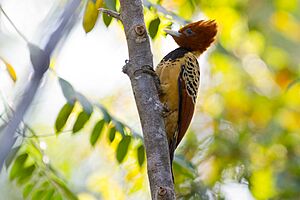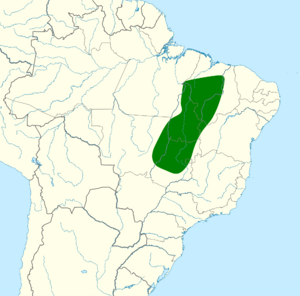Kaempfer's woodpecker facts for kids
Quick facts for kids Kaempfer's woodpecker |
|
|---|---|
 |
|
| Conservation status | |
| Scientific classification | |
| Genus: |
Celeus
|
| Species: |
obrieni
|
 |
|
The Kaempfer's woodpecker (Celeus obrieni) is a special type of bird that belongs to the woodpecker family. It's also known as the Piauí woodpecker. This bird lives only in Brazil.
Contents
Discovering Kaempfer's Woodpecker
How Scientists Name Animals
Scientists have a system called taxonomy to name and group living things. This helps them understand how different species are related. The Kaempfer's woodpecker has an interesting story about how it got its name and how scientists finally recognized it as its own unique species.
A Hidden Specimen
In 1926, a female Kaempfer's woodpecker was found in Piauí, a state in Brazil. This bird specimen was kept at the American Museum of Natural History. However, it wasn't officially described by scientists until 1973! That's a long time for a bird to wait for its official recognition.
Lester Short was the scientist who first described it. He noticed that this bird looked different from other similar woodpeckers, especially the rufous-headed woodpecker. It also lived in a different kind of habitat, and there was a huge distance (about 3,000 kilometers or 1,860 miles) between where it was found and where other similar woodpeckers lived. Because of these differences, he thought it was a subspecies, which is like a special type, of the rufous-headed woodpecker.
Becoming Its Own Species
In the early 2000s, scientists looked at the Kaempfer's woodpecker again. They realized that its unique look, different habitat, and the huge distance from other woodpeckers meant it should be its own full species, not just a subspecies.
At first, it was called the "caatinga woodpecker." But by 2006, scientists realized there was a mix-up about where the first bird was found. So, it got its current name, the Kaempfer's woodpecker.
Who Are Kaempfer and O'Brien?
The bird's English name, Kaempfer's woodpecker, honors Emil Kaempfer. He was the person who collected the very first specimen of this bird back in 1926. The scientific name, Celeus obrieni, honors Charles O'Brien. He was the first person to notice that this bird specimen was truly unique and different from others.
What Kaempfer's Woodpecker Looks Like
This woodpecker is about 26.5 to 38 centimeters (10.4 to 15 inches) long. That's about the size of a ruler! It weighs between 85 and 105 grams (3 to 3.7 ounces), which is like a small apple.
Both male and female Kaempfer's woodpeckers have a reddish-brown head with a fluffy crest on top. Male woodpeckers have a bright red patch on their cheek and some red behind their eye and on their crest. Female woodpeckers do not have these bright red markings.
The back and upper parts of both sexes are yellowish or creamy, with a few black stripes on their shoulders. Their flight feathers (the long feathers on their wings) are reddish-brown. Their tail is black.
Their throat and chest are black, and the rest of their belly is pale yellowish, sometimes with a few black spots. Their beak is light yellow, their eyes are black, and their legs are grayish. Young woodpeckers look a bit duller, with a mostly chocolate-brown head and a reddish-brown crest.
Where Kaempfer's Woodpecker Lives
Rediscovery of a Rare Bird
After the first bird was found in 1926, no one saw another Kaempfer's woodpecker for a very long time, until 2006. People worried that the bird might have become extinct.
But in October 2006, a male woodpecker was caught in Tocantins, Brazil, about 350 kilometers (217 miles) from where the first one was found. Since then, scientists have found at least 25 more of these birds and even discovered some old specimens that had been overlooked.
Its Home in Brazil
These sightings and specimens are spread out over a huge area of about 800,000 square kilometers (308,880 square miles) in northeastern Brazil. This includes the states of Maranhão, Piauí, Tocantins, Goiás, and Mato Grosso.
Scientists are still learning about where Kaempfer's woodpecker likes to live. It seems to prefer areas with bamboo, especially a type called Guadua paniculata. It also lives in Cerrado (a type of savanna) and forests with babassu palm trees.
Kaempfer's Woodpecker Behavior
Movement
Kaempfer's woodpecker stays in the same area all year round. It doesn't migrate to different places.
Feeding Habits
This woodpecker mainly eats ants. It especially likes ants that live inside bamboo, such as Camponotus depressus and Azteca fasciata. It finds its food by drilling holes into dry bamboo stems to reach the ant nests inside. Sometimes, you can see them looking for food alone, in pairs, or even in family groups.
Life Cycle and Reproduction
Scientists don't know much about how Kaempfer's woodpecker reproduces. However, seeing young birds that have just left the nest suggests that their breeding season starts around June or July. This is usually when the dry season begins in their area.
Sounds and Calls
Kaempfer's woodpecker makes a loud, rising squeal followed by a softer, bubbling sound. It sounds like "skweeah kah-kah-kah-kah-kah" or "kreear klu-klu-klu-klu-klu."
It also "drums" on bamboo stems. These drumming sounds are fast and steady, with breaks of about 16 to 20 seconds in between.
Conservation Status
The IUCN (International Union for Conservation of Nature) helps track how endangered different species are. At first, they thought Kaempfer's woodpecker was "Critically Endangered," meaning it was at very high risk of becoming extinct. Then, in 2011, they changed it to "Endangered." But since 2018, its status has been "Vulnerable." This means it's still at risk, but not as severely as before.
The Kaempfer's woodpecker lives in a small, scattered area, and its population is estimated to be around 6,000 adult birds. This number is believed to be shrinking. The biggest dangers to this bird are:
- Habitat loss: Its home is being destroyed or damaged.
- Fires: Wildfires can burn down its habitat.
- Development: New buildings and roads take away its living space.
- Farming: Land is being turned into pastures for animals or farms for crops like soya.
It's estimated that only about 3% of its original habitat is left. What remains is broken up into small pieces, often less than 5 hectares (12 acres) each. Protecting these remaining areas is very important for the survival of the Kaempfer's woodpecker.


